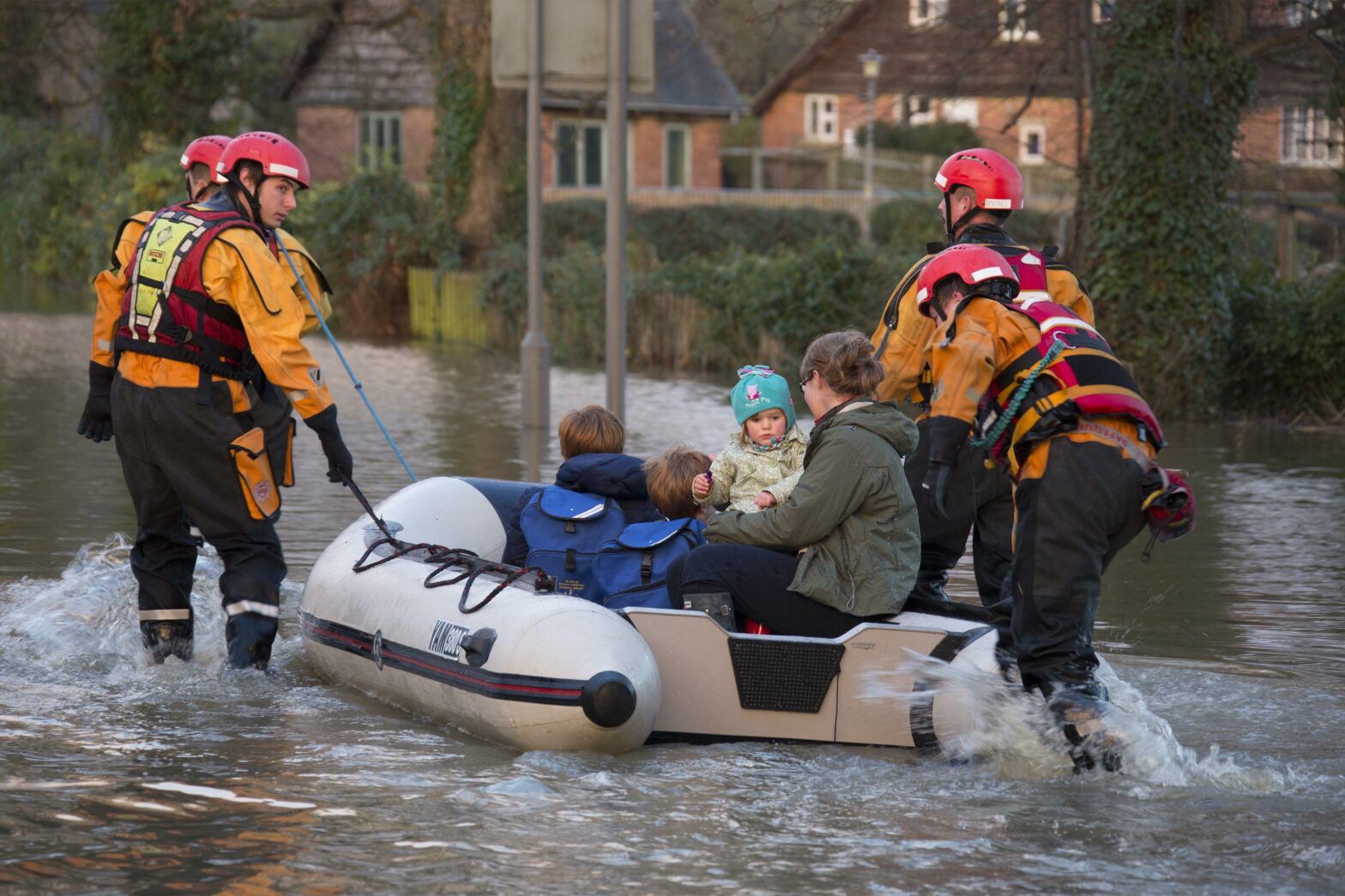Extreme Climatic Conditions: What They Are and How They Affect the UK

Extreme climatic conditions describe rare or unusually severe weather patterns. In the UK, these include prolonged heatwaves, sudden cold spells, intense rainfall, strong winds and drought. These events are becoming more frequent and disruptive, as climate change increases the energy available in the atmosphere. Understanding what they are, and how they affect people, infrastructure and local ecosystems, is an important step in preparing for future risks.
What Are Extreme Climatic Conditions?
Climate describes long-term trends in temperature, rainfall and seasonal behaviour, while weather refers to short-term daily changes. Extreme climatic conditions are when long-term trends include unusually severe or persistent weather. These events fall outside expected seasonal patterns and often have a significant impact on daily life.
Learn more about the difference between short-term and long-term patterns in our post What’s the Difference Between Weather and Climate?
Types of Extreme Conditions in the UK
Extreme conditions in the UK take several forms. Each has unique causes and consequences but all are influenced by shifting climate patterns.
Heatwaves and Hot Weather
The UK is experiencing more frequent and longer-lasting heatwaves. Night-time temperatures are also rising, putting extra pressure on people who are vulnerable to heat stress. Urban areas tend to heat up faster and cool down more slowly due to building materials and reduced green space.
For a deeper explanation, see Hot Weather in Britain: What’s Behind the Rising Temperatures?
Cold Snaps and Winter Weather Extremes
Although winters are becoming milder overall, sudden cold spells can still occur. These are often caused by shifts in the jet stream, bringing Arctic air into the UK. When cold air meets moist air, snowstorms and ice conditions can disrupt transport and strain energy use.
Explore how Arctic air shapes cold periods in Why Is It So Cold in the UK? Weather Patterns Behind Britain’s Cold Spells.
Heavy Rainfall and Flooding
Rainfall in the UK is becoming more intense and less evenly spread across the year. This increases the risk of surface flooding, especially in urban areas with limited drainage. Rivers and coastal areas are also vulnerable to flooding after prolonged or heavy rain from extreme weather events.
Storms and High Winds
The UK is seeing stronger and more frequent storms, which can cause damage through high winds and heavy rain. These systems are often fuelled by warm ocean temperatures and changes in the jet stream. Coastal communities face added risk from storm surges and erosion.
Why Extreme Climatic Conditions Are Becoming More Common
As the planet warms, the atmosphere holds more moisture and energy. This extra energy contributes to more powerful weather systems. According to the UK Met Office and IPCC, climate change is linked to increasing heatwaves, more intense rainfall and stronger storms across Europe, including the UK.
Warming in the Arctic is especially disruptive. It weakens the temperature difference between the poles and the equator, slowing down the jet stream and causing weather systems to linger. This leads to more prolonged periods of heat, rain or cold.
How the UK Is Being Affected
Extreme climatic conditions are already having widespread effects:
- Infrastructure: Heavy rain and wind damage transport networks, power lines and buildings. High temperatures can cause rail tracks to buckle and roads to soften.
- Public health: Heatwaves increase risks of dehydration, heat exhaustion and respiratory problems. Cold snaps raise risks of hypothermia, especially among older adults.
- Agriculture: Crops can be lost to drought or floods. Shifts in growing seasons make food production less predictable.
- Insurance and property: Increased flood and storm damage leads to higher insurance premiums or limited coverage in high-risk areas.
How to Prepare for Extreme Climatic Conditions
Preparation can reduce the impact of extreme events. Individuals and communities each have a role to play.
Individual Preparedness
People can take simple steps to reduce personal risk. These include:
- Checking insulation and ventilation
- Staying hydrated and avoiding strenuous activity during heatwaves
- Knowing local flood risks and checking flood alerts
Find practical advice at Prepare for Heatwaves.
Community and Policy-Level Planning
Local councils are improving emergency planning, flood defences and heatwave strategies. Mapping risks and involving communities in local decision-making helps create more resilient places.
Communities taking local action are building resilience and cutting emissions at the same time. Learn more about these approaches through the 25 Big Local Actions.
Extreme Climatic Conditions FAQs
What are extreme climatic conditions?
Extreme climatic conditions refer to rare or unusually severe weather patterns, including prolonged heat, sudden cold, intense rainfall and strong storms.
What kinds of extreme weather events affect the UK?
The UK faces heatwaves, cold snaps, heavy rainfall, flooding, storms and drought. These are becoming more common due to climate change.
Why are these conditions becoming more frequent or severe?
Global warming increases the energy and moisture in the atmosphere, fuelling more extreme weather. Arctic warming is also disrupting the jet stream.
What are the real-world consequences of extreme climatic events?
Extreme weather affects transport, energy, health, farming and insurance. It causes physical damage, health risks and economic disruption.
How can individuals and communities prepare for extreme weather events?
By improving buildings, checking flood risks, staying informed, and supporting local planning, people and places can reduce risks and adapt to change.
Sources:
- https://www.iow.gov.uk/environment-and-planning/climate-and-environment/climate-change/extreme-weather-events/
- https://www.bbc.co.uk/weather/articles/c1el8z2d7v8o
- https://www.eea.europa.eu/en/topics/in-depth/extreme-weather-floods-droughts-and-heatwaves
About Carbon Copy
Carbon Copy exists to turn individual concern for climate and nature into collective impact by helping people connect locally and create real change together. We believe the fastest way to create change is to share it. We tap into a powerful truth: copying is human nature. When action is visible and easy to replicate, it spreads. It’s about people stepping in, inspired by what others have done and copying what works. Carbon Copy offers a place to start, with a national collection of climate action stories, place-by-place climate and nature plans, a popular podcast and blog, and capacity building for organisations across public, private and third sectors.
Recommended from Carbon Copy
-

Copy these! 5 big local ideas about being more inclusive
Those who feel the impacts of climate change most keenly are often left out of environmental policy conversations. How can…
-

Copy These! 5 Big Local Ideas About Using Decentralised Energy
Communities around the UK are generating their own electricity - through solar, hydro and wind. But how can they ensure…
-

How to Choose a Sustainable Christmas Tree: Real vs Fake
As you’re gearing up for the festive season, the question of which Christmas tree to bring home might come up.…
-
 Food and Agriculture, Good Food, Greater Fairness, Health & Wellbeing, Less Waste, Thriving Wildlife
Food and Agriculture, Good Food, Greater Fairness, Health & Wellbeing, Less Waste, Thriving WildlifeCopy These! 5 Big Local Ideas About Creating A Food Partnership
We all need to eat, and a food partnership is a great way to create a stronger, more sustainable, more…